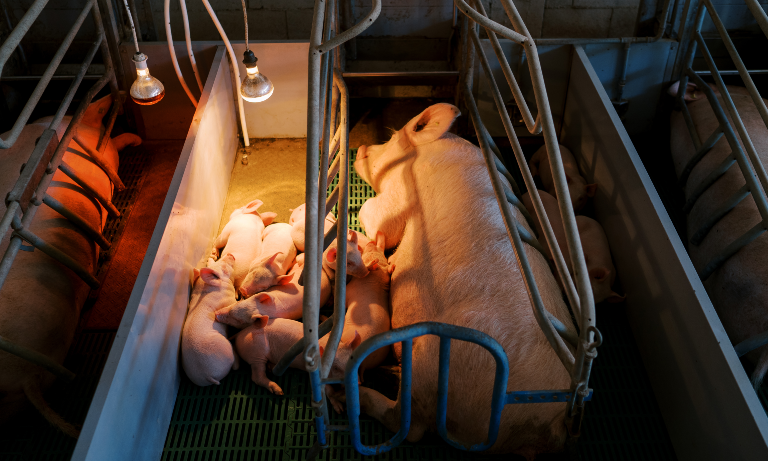Farrowing crates
What's the issue?
Pig farrowing crates confine sows before, during and after the birthing process (farrowing in the sow). Farrowing crates were introduced with the primary aim of reducing piglet mortality by restricting the movement over the sow and thus reducing instances of sows laying on her piglets. Crates do not allow the sow to move from side to side, perform any comfort behaviours, turn around or walk more than one pace forward and one pace backwards.
A farrowing system must provide a balance between sow and piglet health and welfare, staff safety, costs of production, and environmental policy obligations. For the contemporary crate, it is clear that the maintenance of those factors comes at the expense of the welfare of the sow.
What's our view?
Whilst we appreciate the need to keep piglets safe in the critical periods post birth, it is clear the current crate system can be improved to maintain the protection for piglets whilst also supporting higher welfare outcomes for the sow. When looking at the current farrowing crate system with reference to the 5 Domains Model for animal welfare assessment we have to conclude the current system does not support the sow and her piglets across all 5 of the domains. The system has to be changed. The key improvements that the new system will need to factor in are increased space for the sow to move around, provision of extensive nesting materials to allow for successful completion of a nest for the sow, a reduction in the length of confinement in the crate itself, and it must have a safe area for piglets.

Recommendations
In our joint policy position with the Pig Veterinary Society (PVS), we recommend:
- UK Government should ban farrowing crates in their current form and replace them with a system that maximises sow and piglet welfare and ensures human safety.
- A clearly mapped out 15-year transition period should be implemented. From the date of the ban all new builds cannot include the current farrowing crate unless already agreed upon. We would encourage new builds to either be a form of adaptive farrowing accommodation or free farrowing. At the end of the 15-year transition all systems must not contain the current farrowing crate unless it is those which were built during the transition period as previously agreed so these systems would be in place for the functional life of the building and would then need to shift systems.
- If the adaptable farrowing accommodation is selected as an alternative, the length of time the sow is kept within the crate should be in line with the Agriculture and Horticulture Development Board recommendations of 2-7 days. Variability is to be expected and should be considered by the farmer and their veterinary practitioner to ensure the safety of the piglets and not keeping the sow confined unnecessarily. There will need to be a clear and very specific definition of what will be acceptable, agreed well in advance, to ensure producers replacing existing farrowing accommodation are able to assuredly construct what will be acceptable / required under any new legislative proposals
- The stages of shifting away from the current system to the new system must be clearly laid out and adequately funded by the UK Government and the governments of the devolved nations where appropriate. Planning permission and adequate resource must be made available too. Any transition away must factor in the direction of travel in the EU to ensure symmetry and equal opportunities for UK producers.
- UK Government, the governments of the devolved nations and supermarket retailers should also carry out an awareness raising campaign around farrowing systems and the incoming changes to inform consumers ahead of the ban and during the transition period.
- During the transition period, there should be shared learning of best practice to enable farmers and producers to confidently and competently support animal welfare in the new farrowing accommodations.
